iFi Diablo 2 Review & Measurements - Manufacturers need to stop doing this!
Introduction
The iFi Diablo 2 is the successor to the original Diablo, and the latest in iFi’s ‘Micro iDSD’ lineup, which previously included the iDSD black label and iDSD signature. This lineup aims to provide more substantial power capability than the majority of portable sources, with some additional features on top.

Design and I/O
The Diablo 2 has quite substantial changes to the I/O compared to its predecessor, with a combo SPDIF port alongside two USB-C ports now present on the rear, one for charging/power, and one for data, allowing the user to use the Diablo 2 as a desktop source should they wish as well as a portable device.
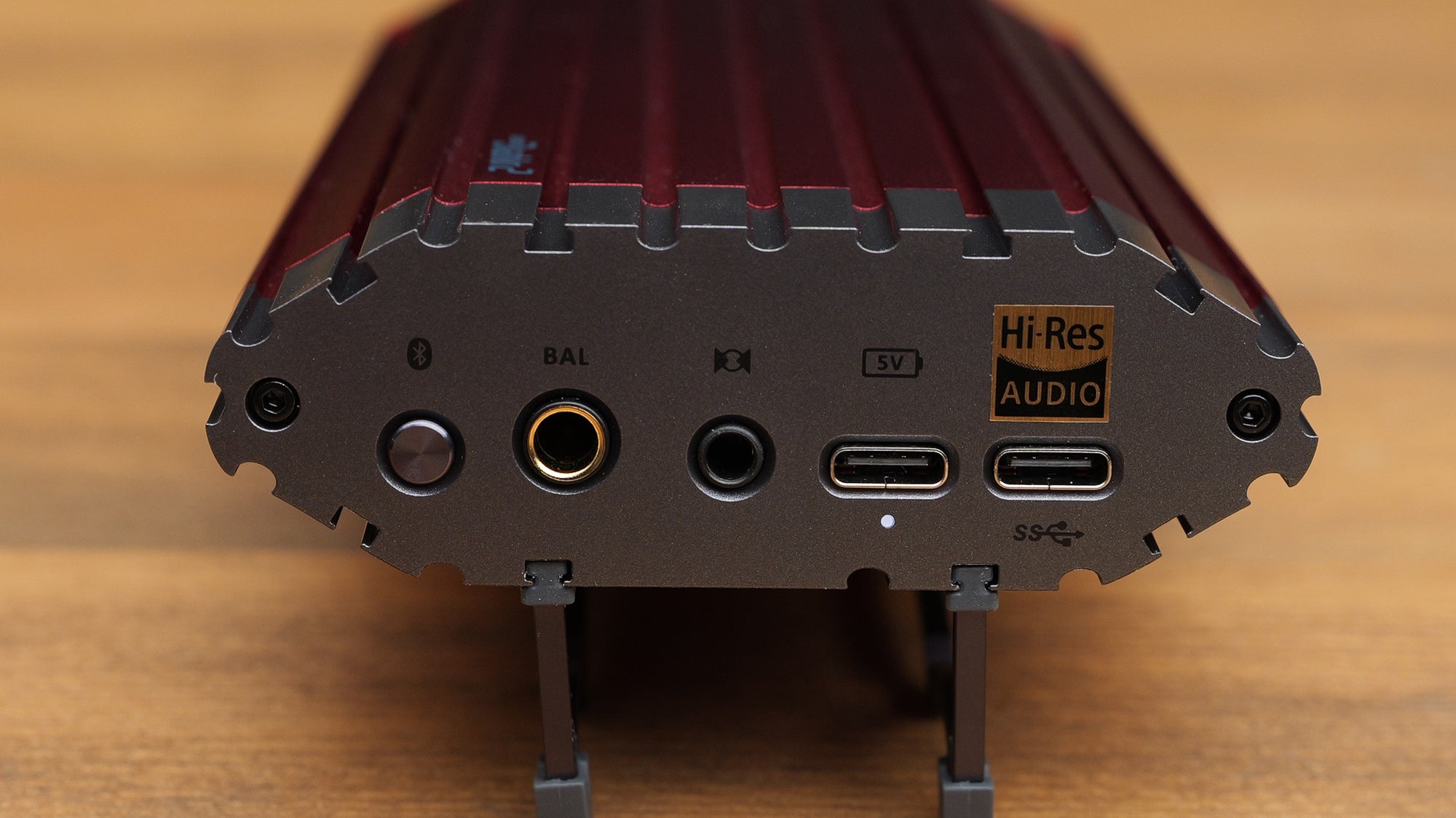
This is further helped by the included wings that are new to the Diablo 2. A pair of flat and a second pair of angled wings can be slotted into the device to stand it at an angle and improve ergonomics when used at the desk. (As well as looking quite nice!)
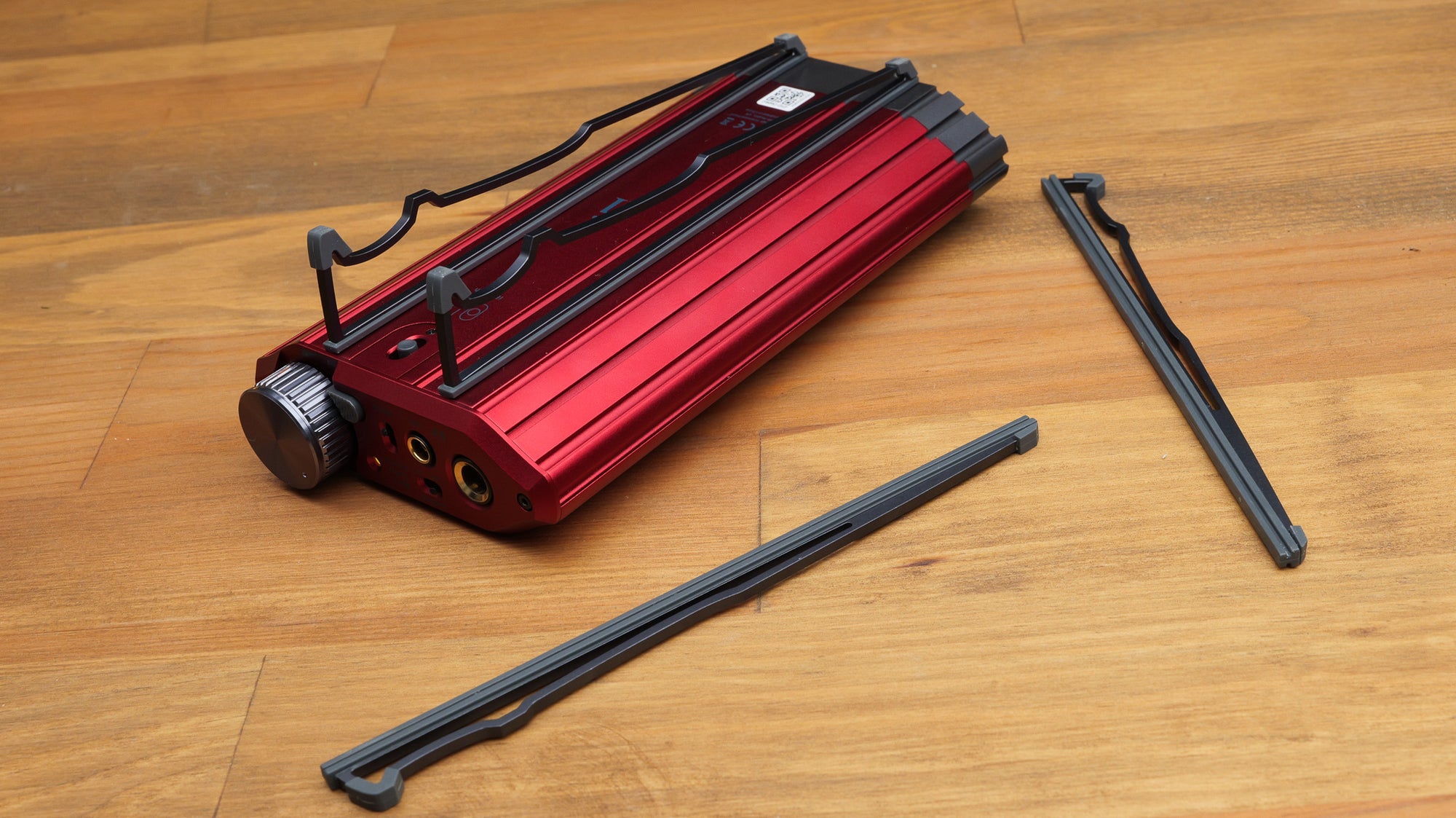
The rear of the device also features a 4.4mm port that can be used as a DAC line out, or an analog input, so that users can utilise the Diablo 2 as a DAC/Amp combo or a standalone amplifier fed by an external DAC.
Besides feeding the Diablo with a normal analog or digital SPDIF/USB source, it’s also one of the first products to incorporate aptX lossless bluetooth, which provides true lossless, uncompressed audio transfer if you have a supported device. (At the time of writing, neither Apple nor Samsung devices support this protocol, though other Android devices do.)
The front of the unit provides a balanced 4.4mm and 6.35mm single ended output, though unusually the available power on the Diablo 2 is greater on the single-ended output, as we will discuss later in this post.
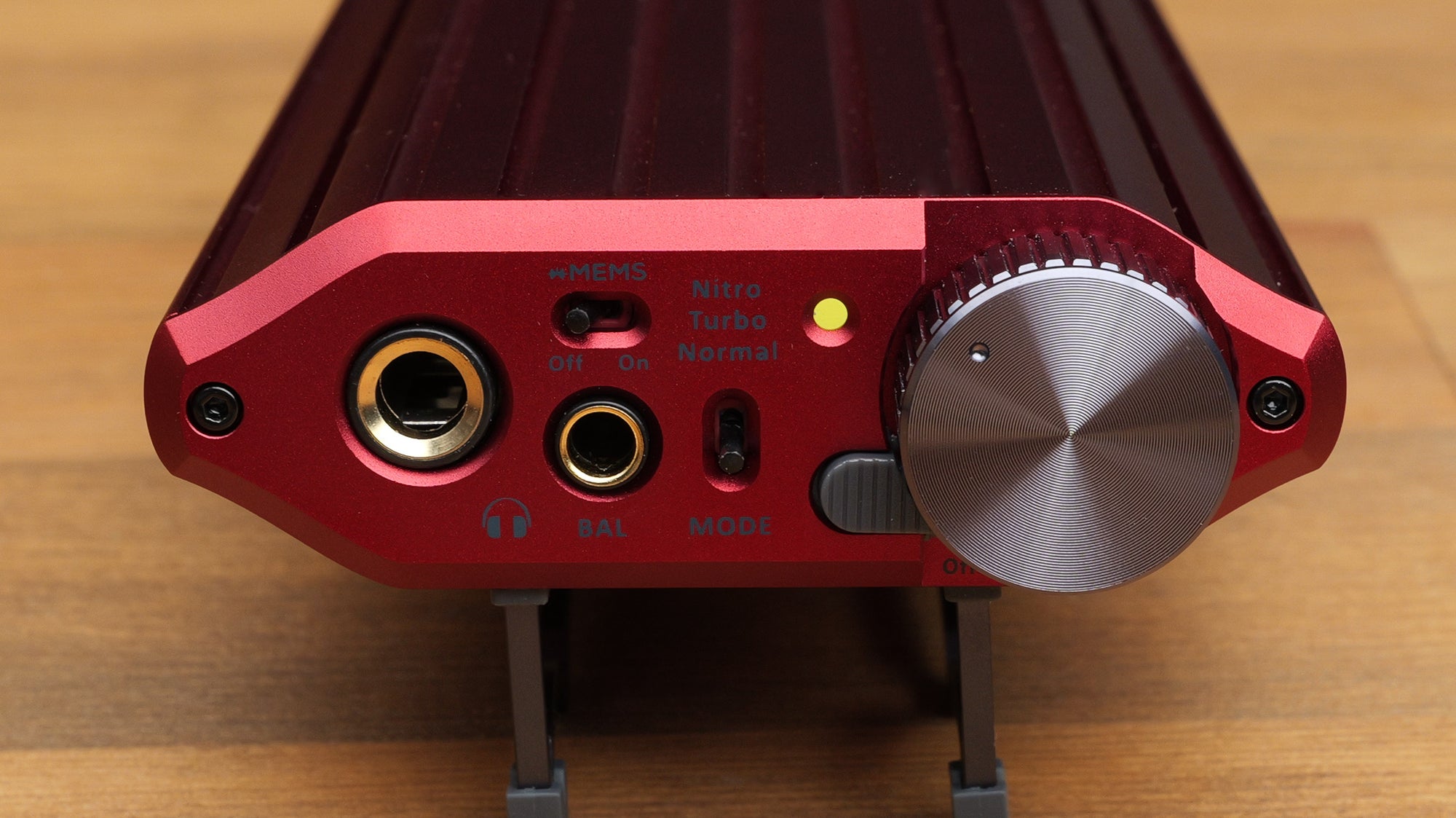
New to the Diablo 2 is the XMEMS toggle, which applies a bias voltage to the output, enabling the use of XMEMS driver headphones. This is a very nice inclusion and hopefully XMEMS based products become more prominent in future. And the final new feature is a lock for the volume knob, allowing the user to ensure the volume stays in one position when the device is in a pocket or bag.
Unfortunately, the combination of the higher than usual gain setup on the Diablo 2, with low gain being 0dB rather than a negative gain as found on many amps, as well as the volume pot used, does mean that for IEMs, volume control can be difficult, either because the volume has to be adjusted in extremely tiny movements else it gets too loud, or because the pot incurs channel imbalance at low levels.
Luckily, the Diablo 2 sees the return of the inbuilt IEMatch, a feature that was present in the iDSD signature and iDSD Black Label but missing from the Diablo 2. This puts a resistor in series and in parallel with the output, attenuating the output signal and providing both an improvement in noise floor and more volume control range with IEMs. The downside is that it increases the output impedance of the Diablo 2 from <1 Ohm to 6 Ohms, which will alter the frequency response of most IEMs to some degree.

Frustratingly this feature wouldn’t really be needed if the Diablo 2 had a lower gain setting. The lowest gain is 0dB, whereas many amps have a negative gain setting. This makes volume control for IEMs quite difficult. This would be a bit more understandable if the highest gain was more….well….usable. With a 32 Ohm load in high gain, the device will outright shut off once the vol control passes about 1 o’clock. And even with a 600 Ohm load or completely unloaded, it simply hard-clips past about 3 o’clock, making such a high gain setup seem quite sub-optimal. It would have been much better to see a high gain setting that was more suitable for the device’s output capabilities, and a low gain that was lower to provide a better experience with IEMs.
Sound Quality
In terms of sound quality, the Diablo 2 sounds remarkably similar to the Diablo 1, and as it turns out, objectively behaves near identically as well. It provides an overall slightly bright/aggressive sound, though one that is quite resolving and technically capable if a little too forward at times.
Transients are snappy and precise, and it doesn’t struggle with harder to drive headphones such as the Hifiman Susvara, remaining clean, controlled and authoritative. However this is not due to the maximum power available, as unfortunately the claimed 5W spec is obtained using an unorthodox test methodology. In fact the maximum power available is 2.3W on single ended or 1.6W on balanced when the device is plugged in. (Values on battery seem to depend on the battery level but are roughly half the numbers attained when connected to an external power supply)
This is instead simply due to the fact that the Diablo 2 doesn’t degrade in performance as it approaches its maximum output level of about 2W, whereas many amps even if they can pump out 6W+, may be seeing rapidly increasing distortion past even half a watt or so. The Diablo 2’s marketing of 5W is misleading, though it is still a good choice for a portable source to drive difficult headphones. See our video on ‘Do I need an amp?’ to learn more about this!
The challenge is that to my ear, the Diablo 2 and in fact the Diablo 1 simply don’t sound as good as the iDSD signature, and with the Diablo 2 now costing over twice as much as the iDSD signature, that makes it a bit of a tough pill to swallow.
The Diablo 2 is considerably leaner overall in sound compared to the Signature, and whilst it does offer an improvement in resolution, the Signature was better in realism of instrument and vocal timbre, offered a slightly larger soundstage, and also included extra customisation features such as crossfeed and bass boost EQ to allow the user to tune things to their liking.
The Diablo 2 is a roughly 50% increase in price over the Diablo 1, but to my ear offers if anything a very marginal improvement in sound quality. The main source of which seems to be from an improved oversampling filter, as the distortion profile and behaviour in most other areas seems to be essentially identical.
Measurements
If you’d like an explanation for any of the measurements shown that you’re not sure about, check out our glossary of audio measurements and design terms!
Measurements Include:
- THD+N (SINAD)
- THD+N vs Frequency
- Low Level Signal Output
- Reconstruction Filter/Upsampling
- Jitter
- THD vs Output Level
- Linearity
- Output Impedance
- Power On/Off Behaviour (Safety Test)
- Noise
- Intermodulation Distortion (IMD)
- Dynamic Intermodulation Distortion (DIM)
- Crosstalk
- Multitone
Additional measurements and test information available in the full report
Test Setup
- Audio Precision APx555 B-Series analyzer
- Measurement setup and device under test are running on regulated 230V power from a Furman SPR-16-Ei
- Diablo 2 was warmed up for 2 hours prior to testing
- USB input, Single-Ended output used unless otherwise specified
- Tests shown are with a 32Ω load unless otherwise specified
- Exact analyzer/filter configurations for each measurement are detailed in the full reports
- CH1 (Blue) = Left, CH2 (Red) = Right
Full Measurement Reports
Results
Dynamic Range (AES17): 108dB
SNR: 110dB
IMD SMPTE: -90dB
DC Offset: 2.7mV active, 2.7mV idle
Susceptible to intersample overs: Yes
Gain: 0dB (Low), 8.5dB (Med), 17dB (High)
Output Impedance: 0.35Ω (Standard), 5.75Ω (IEMatch Enabled)
THD+N / SINAD
Disclaimer: SINAD should not be used as a figure to judge the overall performance of a product, it is a figure that combines several aspects of performance into one number whilst not including many others. It should be used as one factor among many when evaluating the overall objective performance of a device, and the type/structure of distortion can often be more important than the level of distortion/noise itself.
0dBfs 1khz Sine, DAC Balanced Output:
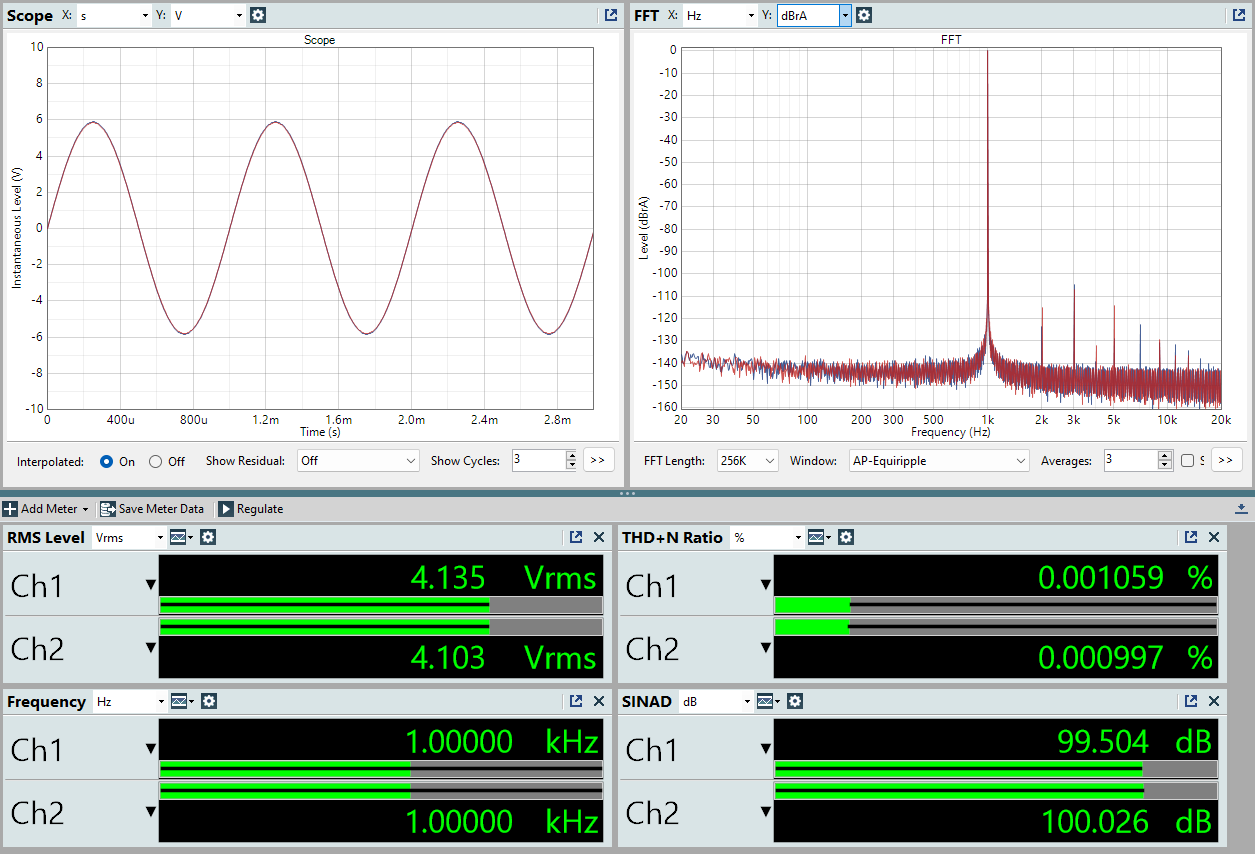
1khz Sine, 4V 4.4mm Output (32 Ohm Load):
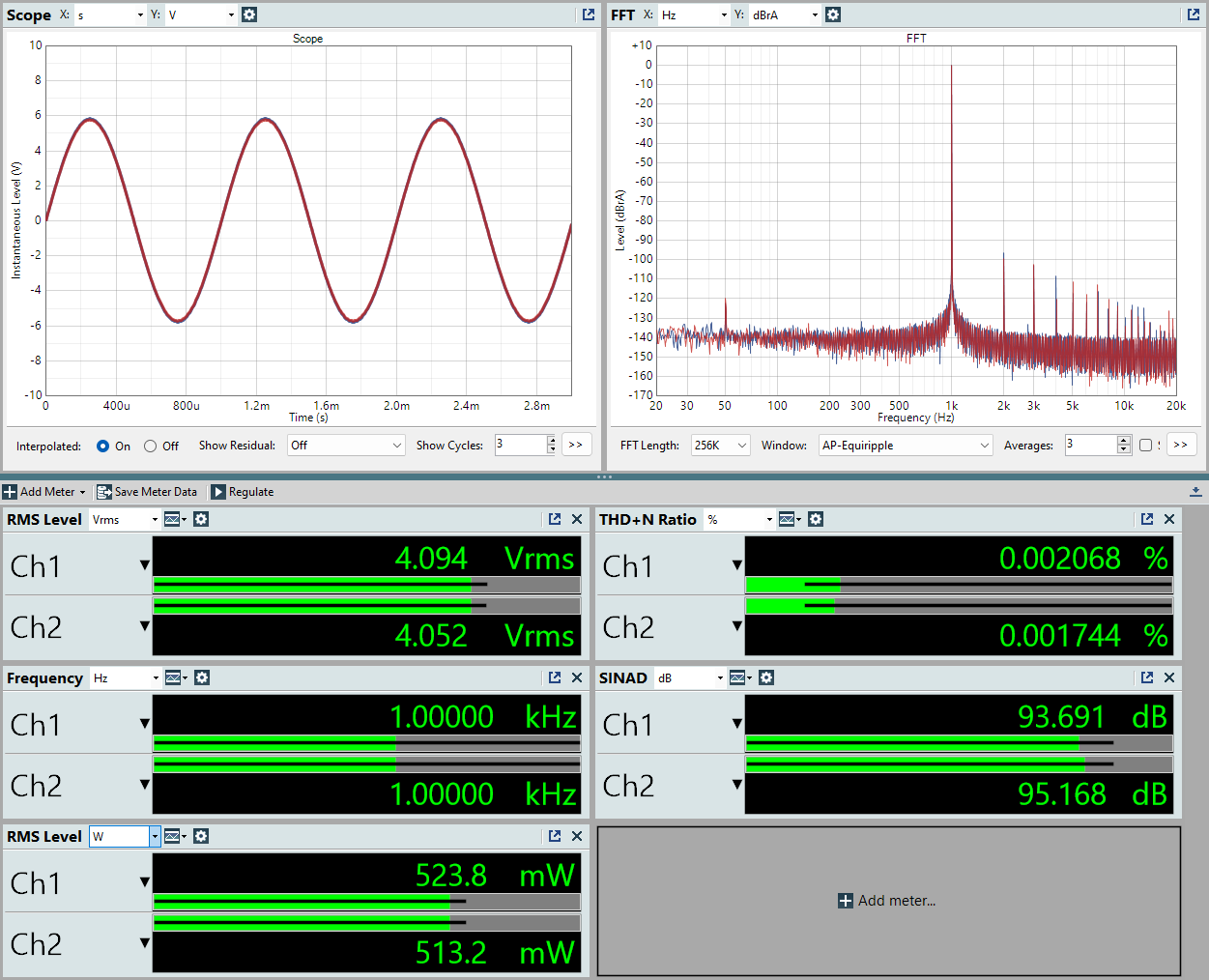
1khz Sine, 50mV 4.4mm Output (12 Ohm Load) - IEMatch Disabled:
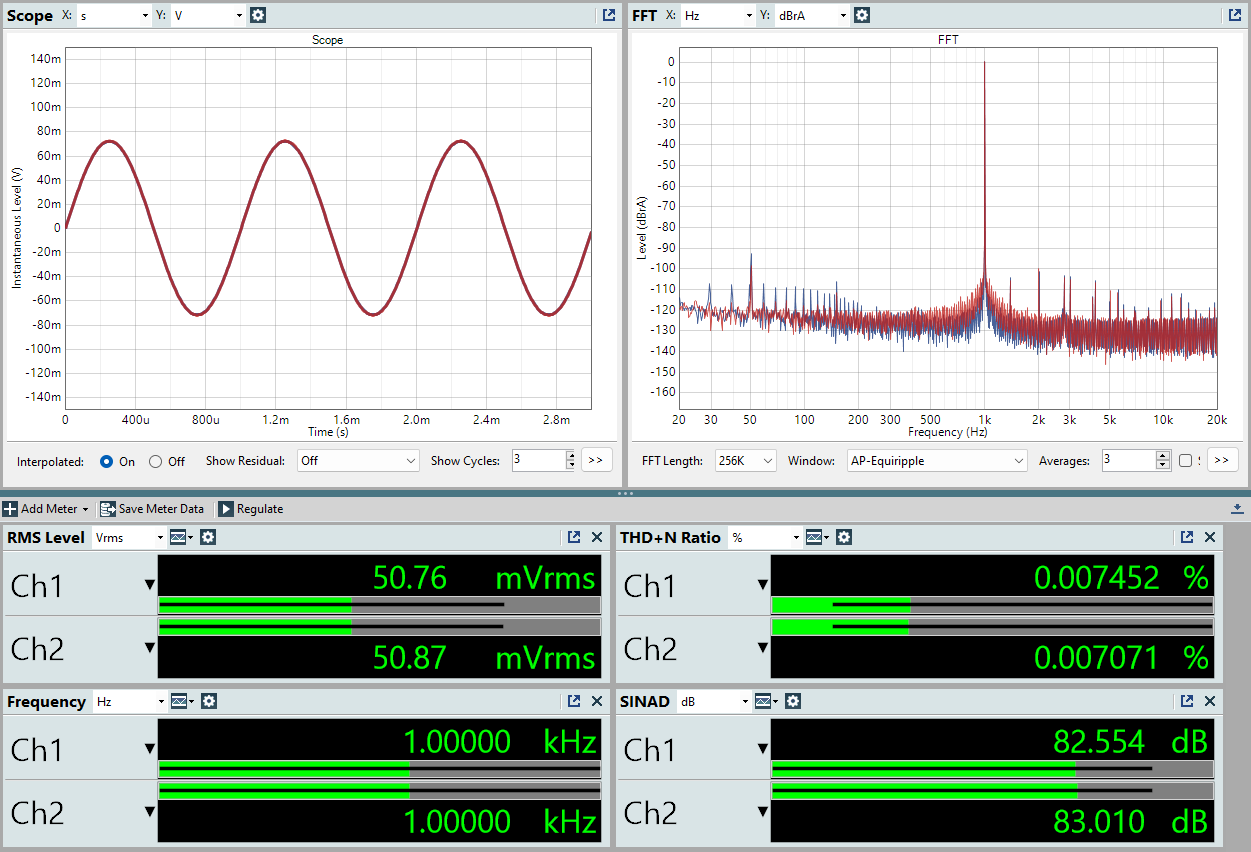
1khz Sine, 50mV 4.4mm Output (12 Ohm Load) - IEMatch Enabled:
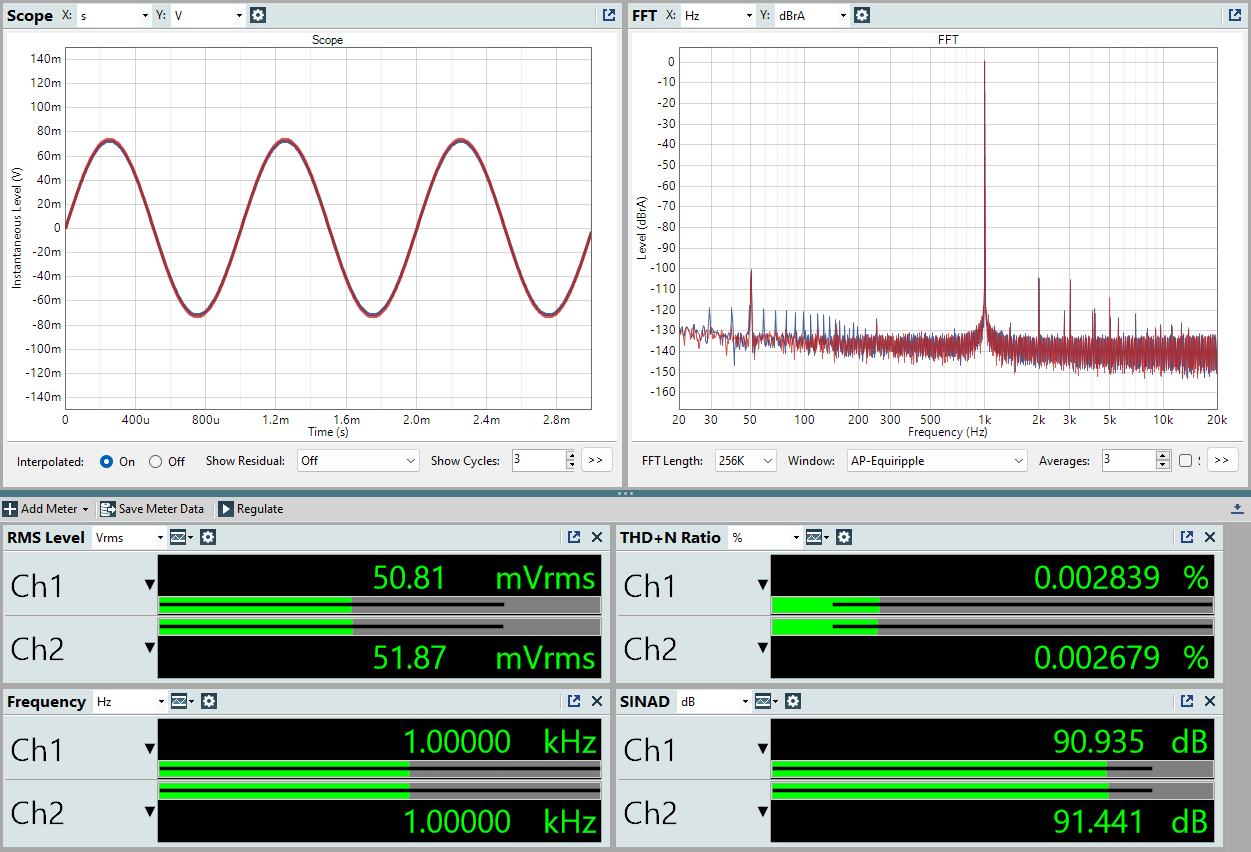
IEMatch does provide a nice improvement in dynamic range for IEM users. And will make volume control easier.
THD+N vs Frequency (96khz capture bandwidth)
(96khz bandwidth used on the analyzer. Don’t compare this directly to standalone audible band THD+N measurements as the measurement setup is not the same.)
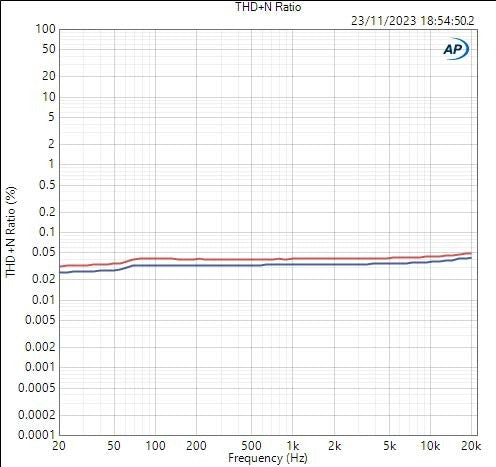
Low Level Signal Output
This test plays a very low level signal through the device to check for any unusual behaviour.

-90.31dBfs 24 bit dithered sine
Reconstruction Filter (Nyquist/Oversampling Filter)

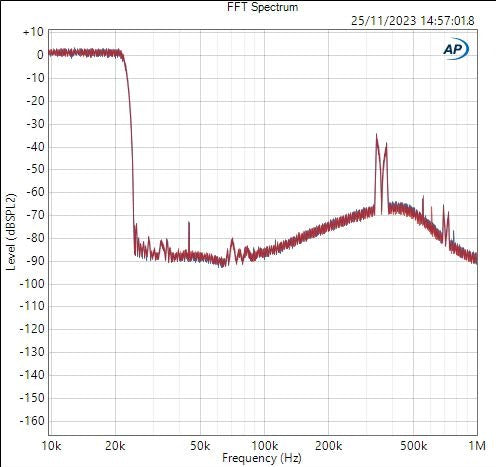
Reconstruction filter performance is improved from the Diablo 1. There is a bit of unwanted content out near 350khz but otherwise decent.
Jitter
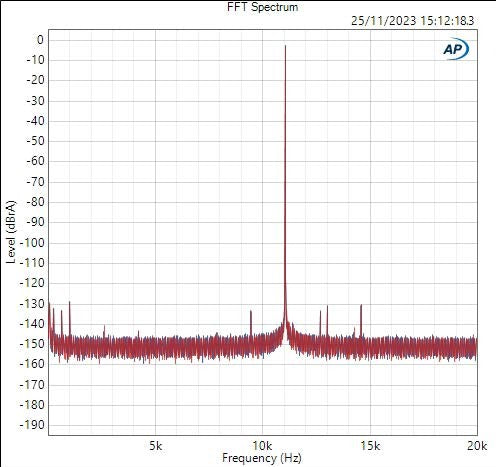
Jitter is not perfect but still good.
THD vs Output Level (4.4mm DAC output)
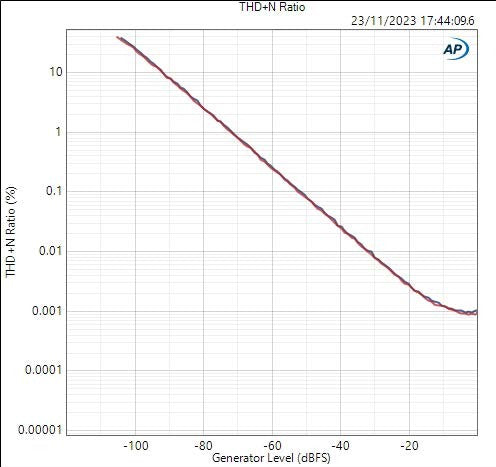
Only a very slight increase in THD toward the upper levels of output, you can try adding a few dB of digital headroom in your player to see if it makes an improvement (this will also alleviate the susceptibility to intersample overs), but don’t worry about this.
Linearity
This test plays a 1khz tone through the device, and steps down the level in small increments. Linearity measures how accurately the actual output of the device reflects the intended output. For example, if the level was stepped down by 20dB, but the output of the device was 19.7dB quieter, there is a 0.3dB nonlinearity, which would show as a 0.3dB rise on the graph.

Bandpass filtered, this is measuring only the accuracy of the 1khz tone itself
Interestingly here the linearity goes down toward the lowest levels, meaning the signal is lower than anticipated. Usually this would go up as noise becomes a larger part of the signal, increasing its amplitude, but this could be due to a quirk of either the Burr Brown DAC’s architecture or the feedback design utilised in the Diablo 2.
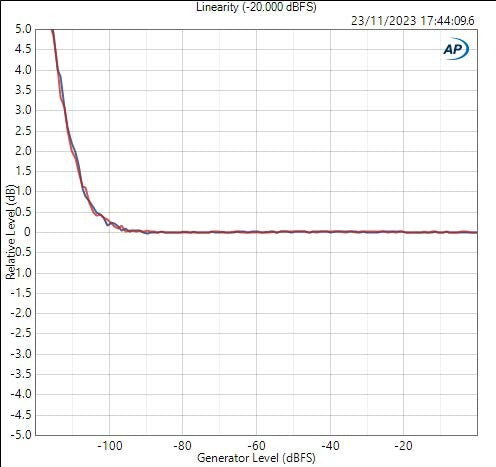
No bandpass filter, this factors in noise into the result
Noise
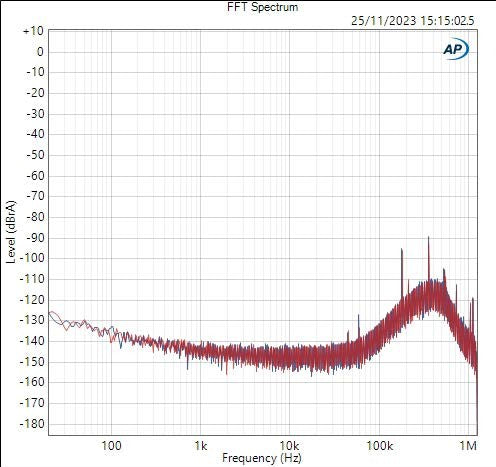
256k FFT, 3 Averages
Some ultrasonic switching components observed but kept at very low levels.
IMD

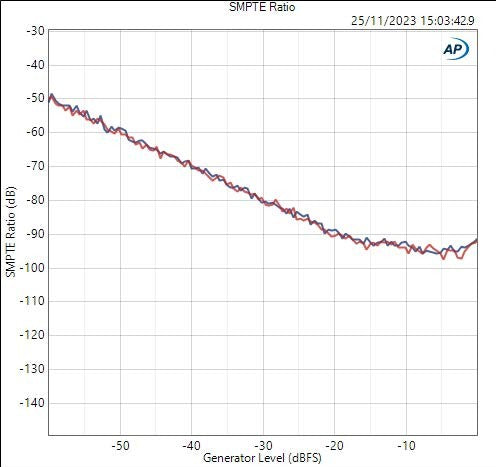
Crosstalk
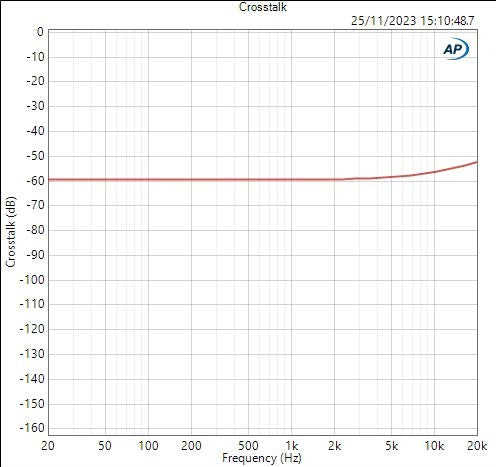
Crosstalk is reasonably high. This seems to mostly be a limitation of the amp stage. The DAC output sees increasing crosstalk toward 20khz (the tail end of which is visible here) but especially when under load, the amplifier has fairly high crosstalk.
Multitone
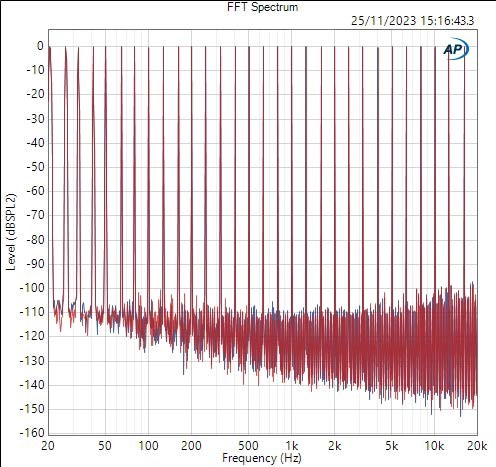
Conclusion
Overall the Diablo 2 disappoints by not living up to the promises made in the marketing material. It’s simply not as powerful as it’s made out to be, and additionally does not bring much improvement in sound over its predecessor whilst being about 50% more expensive. The return of features such as the IEMatch are most certainly welcome, though would not really be needed in the first place if the Diablo 2 had a more reasonable gain setup. The high gain structure means it’s difficult to use for IEMs, whilst also being somewhat pointless for harder to drive headphones as on max gain the device cannot even operate past 1-3 o’clock without clipping or shutting off entirely.
Overall, I can’t recommend the Diablo 2 when iFi’s own iDSD signature offers a better result for less money, and if power is your main goal, alternatives such as the Centrance ampersand can deliver more power on battery than the Diablo 2, with a more neutral sound, for nearly half the price.
